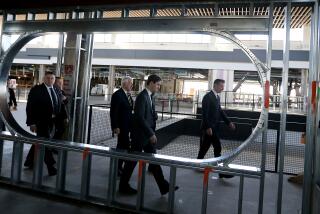Supercomputer Time Sales Lag at UCSD Center
- Share via
Facing reluctance from businesses concerned about bottom-line costs, the Cray supercomputer center at UC San Diego has signed contracts with only five industrial firms since it opened amid much hoopla last fall.
Despite strong support from corporate scientists, officials at the UCSD facility haven’t been able to persuade corporations to include supercomputer center research grants or equipment donations in their capital budgets.
But UCSD isn’t alone. A similar center at the University of Illinois has signed only one major industrial contract in the last year.
“These are businessmen that we’re dealing with, and they want to know the return on their investment,” said supercomputer center spokesman Robert Randall.
Unless a corporation’s top managers understand the supercomputer’s capabilities, “their response usually is ‘We’ve got enough of our own computers already,’ ” according to one corporate computer scientist who has lobbied his company to support the San Diego center. The supercomputer can produce 800 million calculations per second.
Since March, when Aerojet General became the center’s first industrial partner with a $1-million research grant, the center has signed industrial research agreements with M/A-Com, Science Applications, GA Technologies and Los Angeles-based Omnibus Inc.
“We still have plenty of opportunities for corporations,” said Randall, manager of resource development. “We’d like industrial participation, and we’re continuing to work at getting that participation.”
The center needs industrial participation--both financial help and equipment donations--to help cover a $7.5-million shortfall over the next few years. That shortfall will occur despite funding from the National Science Foundation and financial support from the state of California.
If corporate support fails to materialize, the center would be forced to scale back the planned addition of computers during coming years, Randall acknowledged.
“A supercomputing center can’t rest on its laurels,” Randall said. “You have to be looking to the future to make sure that you have the latest, fastest, most powerful computer available.”
Not surprisingly, the center has drawn strong support from corporate scientists, who understand the Cray’s super-fast computing capabilities. Scientists don’t control corporate purse strings, however.
According to National Science Foundation regulations, as much as 10% of the San Diego center’s 30,000 annual hours of computing time can be reserved for industrial users. The same criteria apply to the three other National Science Foundation-funded supercomputing centers at the University of Illinois, Princeton University and Cornell University.
Aerojet General agreed to finance basic research related to an air turbo ramjet that the San Diego-based company is designing. The power plant would power a hypersonic airplane that would use Aerojet General-produced engines. Aerojet, which has yet to link its various computer centers to the San Diego Supercomputer Center, is “still finalizing how to best use the center,” according to spokesman George Segala. “And we’re still trying to work out the mechanics of (linking the center) to our various divisions.”
“There are a lot of people licking their chops for the chance to get at the more modern computing at UCSD,” said Donald Mathews, a senior staff nuclear engineer at GA Technologies, which also has contracted to use the UCSD supercomputer. “There are things you can do with a state-of-the-art computer that you just can’t do on older machines.”
The supercomputer’s main attraction is its speed, according to Thomas La Fleur, director of management information systems at M/A-Com Telecommunications Division.
That number-crunching capability has excited M/A-Com scientists who, using existing machines, spend as long as four days to design and model custom, very large scale integrated circuits. Operating with properly designed software, a supercomputer can trim that time to less than 40 minutes, according to La Fleur.
However, to achieve such condensed schedules, M/A-Com’s computer specialists must determine which projects are suited for a supercomputer and design software packages that can harness the mind-numbing capabilities of supercomputers.
“If you can get things running on one of these large machines, it doesn’t cost much more than the old machines,” Mathews said. “It only costs twice as much to use but you get things running 10 times faster, so they’re much more cost-effective machines.”
GA Technologies, in addition to contracting with the NSF to operate the UCSD Supercomputer Center, also has signed research agreements with the center.
From an engineering standpoint, the supercomputer allows scientists to fine tune their modeling exercises, said Mathews, who explained that the Cray “uses newer calculation techniques that consider more details.”
GA has used the supercomputer to model the “power, temperature and other considerations for a nuclear reactor we built in Colorado,” Mathews said. “These are things we’ve done to a lesser extent by hand and with our older computers.”
Although it is expensive to buy supercomputer time, it is cost-effective, La Fleur said.
That cost effectiveness is evident even at a company such as M/A-Com, which has 26 large computers, La Fleur said.
“We can boost productivity if one of the new computers can do in minutes what used to tie up a (large computer) for three days,” La Fleur said. “That’s trimming back some pretty expensive computer time.”
To attract smaller companies, the center is offering 2 to 20 hours of computer time and training through the UCSD department of engineering’s industrial liaison program.
“These (smaller companies) don’t have a million dollars to go out and buy a Cray and they might be getting along fine with a (smaller computer),” according to Marilyn Wilson, UCSD corporate liaison director.
“It’s a little frightening for some people to have to think about a new technology like a Cray. That’s whey we’re concentrating on the training aspects.”






